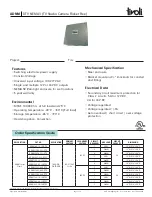
FCC ID: K6630443X3D
IC: 511B-30443X3S
Alignment
3/5
Vertex Standard Co,. Ltd.
Overview of Test Mode
The test mode has been build in the microprocessor in order to adjust and confirm the
performance of transceiver.
The purpose is to adjust transceiver simply and to confirm the performance of
transceiver smoothly.
(A) In CH70, every time you are in transmit mode, (every time you press PTT), the
following test tone can be outputted:
1st transmission: 1300 Hz
2nd transmission: 2100 Hz
3rd transmission: No modulation
4th transmission: Synthetic tone of 1300 Hz and 2100 Hz
5th transmission: Return to 1st transmission
(B) Scan the channels between WX10 and EXP04 in the SCAN mode.
Starting Test Mode
Confirm that
PWR/VOL
switch is off, and short the TEST points(JP1001).
Press and hold the
PWR/VOL
switch until the radio turns on while press and holding the
DIST
and
CLR / WX
keys.
Adjustment and Confirmation of Transmit Power
Adjust power at high and low in the transmit mode, and confirm power in the specified
bandwidth.
-- Adjustment --
Connect the wattmeter and 50-ohm dummy load to the antenna jack.
Use
the
H/L
key to set transceiver to
high power
and set the channel to
CH16
. With
the
PTT
switch pressed, adjust
VR1001
so that RF power is 24 W.
Use
the
H/L
key to set transceiver to
low power
and set the channel to
CH16
. With
the
PTT
switch pressed, adjust
VR1002
so that RF power is 0.8 W.
Adjustment and Confirmation of Deviation
Adjust deviation in the transmit mode.
-- Adjustment --
Setup the test equipment as shown below.
Set the channel to
CH16
.
Set the output of the audio generator (AG) to 1 kHz and 200 mV.
With
the
PTT
switch pressed, adjust
VR1003
so that the maximum deviation is ±4.2
kHz.























